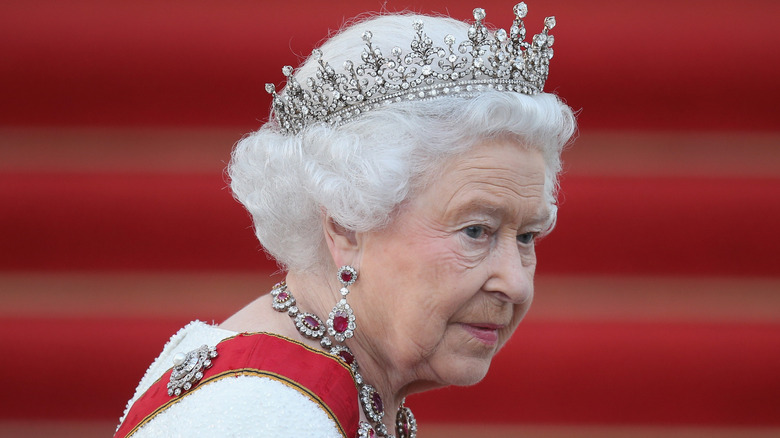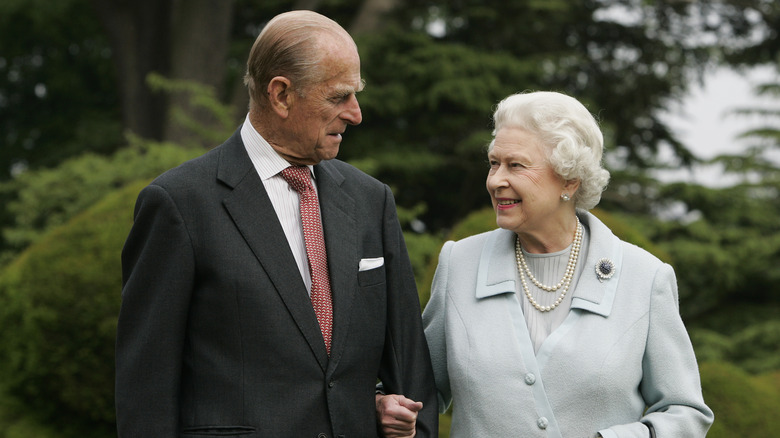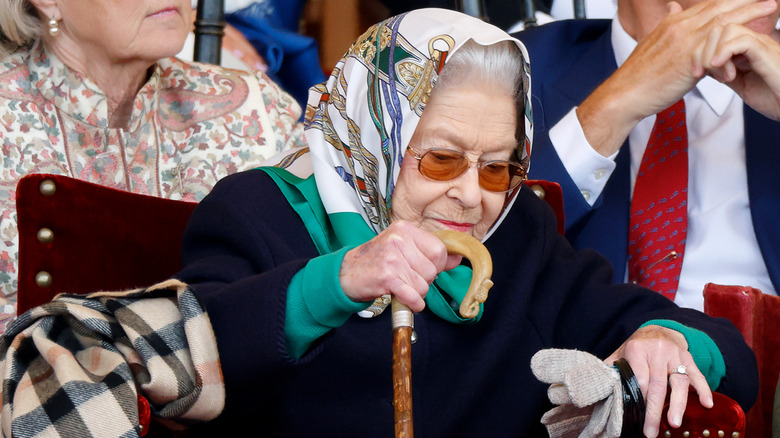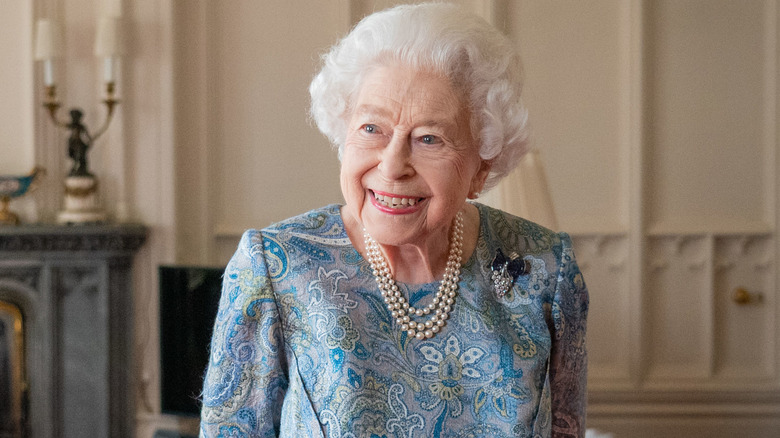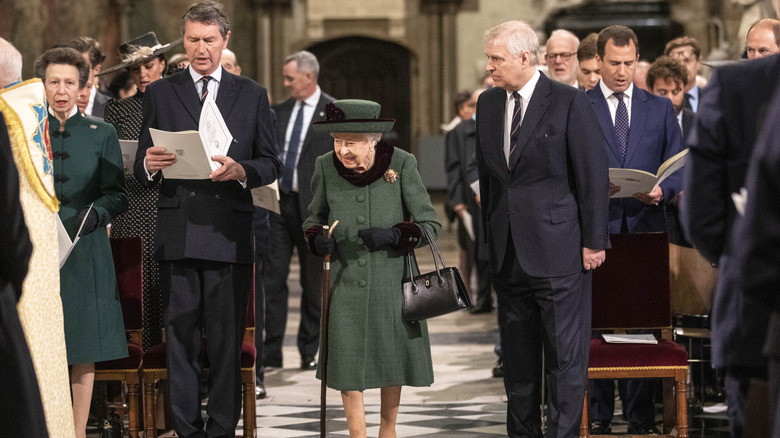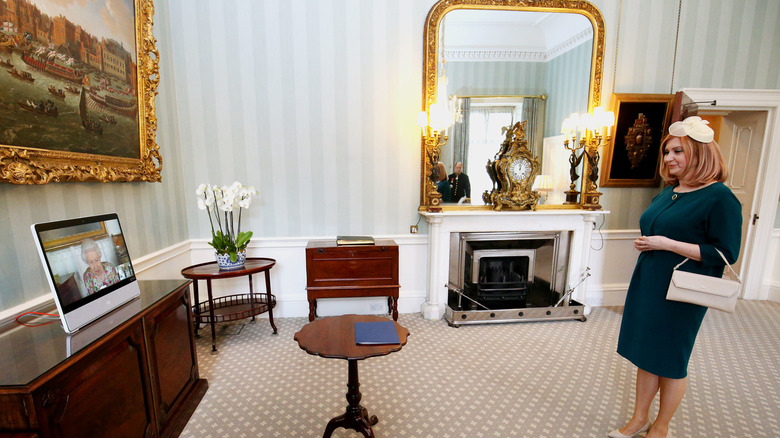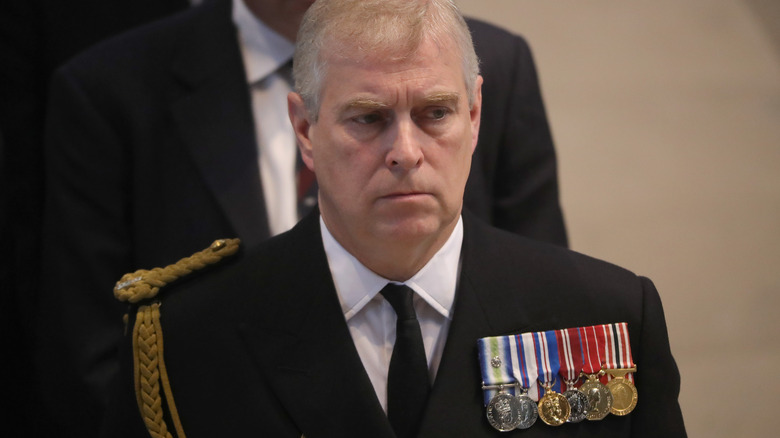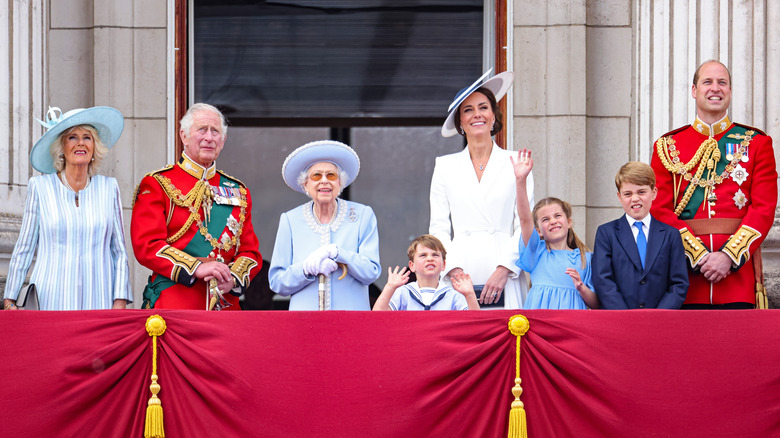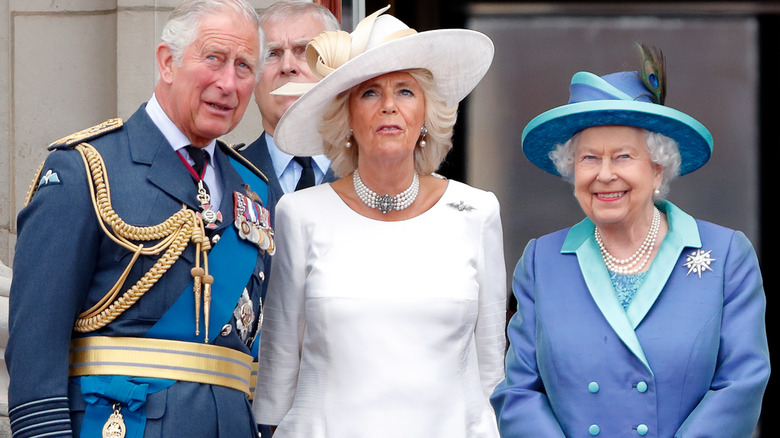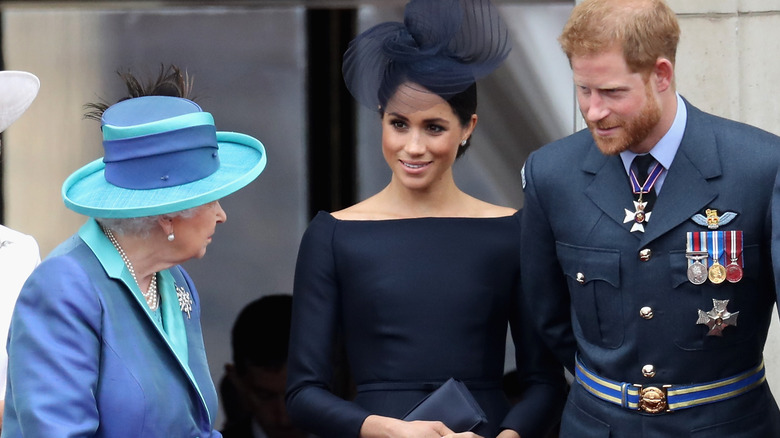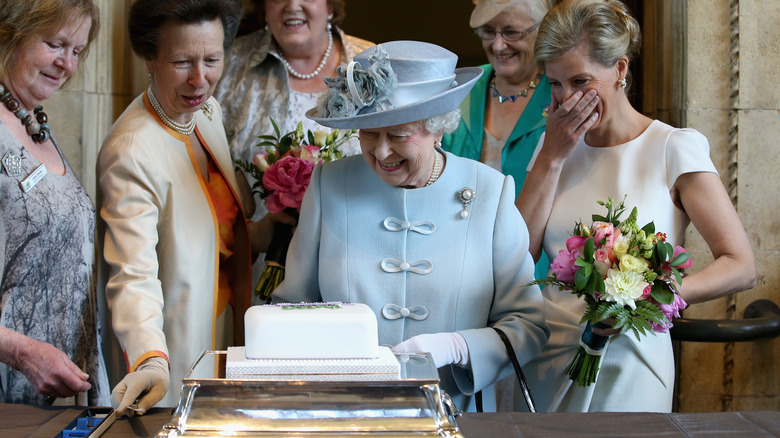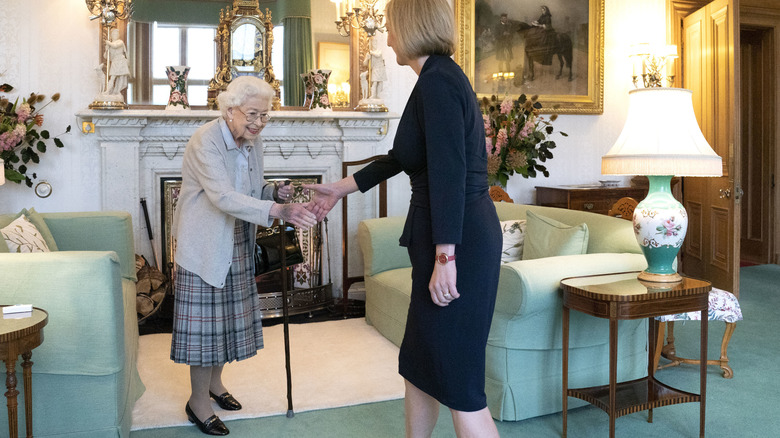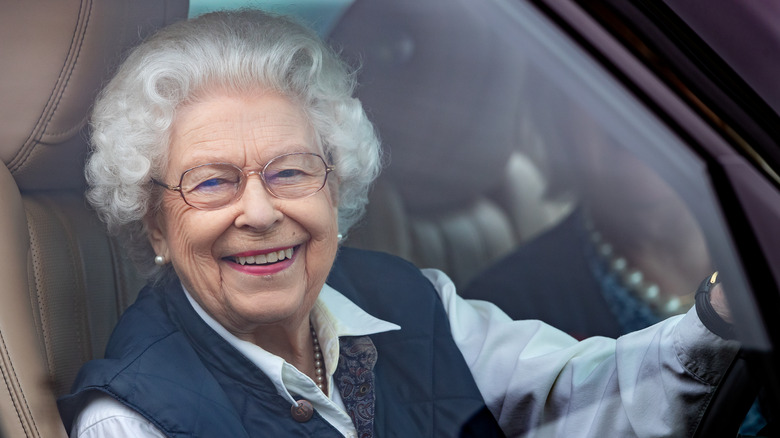What The Last 12 Months Of Queen Elizabeth's Life Were Like
As people remembered Queen Elizabeth II, phrases like "defined an era" and "Great Britain's continuity" were often used. A lot can be said about her multi-decade reign, the longest of any British sovereign ever, per NPR. But the queen's final year, a year defined by an easing-back of public duties and appearances, was mostly defined by more private moments and a quiet preparation for a future she would not be part of. She granted Prince Charles the confidence to reign by granting a new title to Camilla Parker-Bowles, putting them on a path for success, reports CBS News. Meanwhile, she carried out her last duties as Head of State by blessing the future prime minister whose tenure she would not live to experience, according to Today.
It's that diligence to duty, despite all other troubles or distractions, that defined her reign and earned the admiration of Britons for so long. Even when the queen underwent health struggles in her final months and had trouble moving around physically, she merely transferred her duties to online Zoom meetings, per CNN. And even if she still held her son Prince Andrew close to her heart, she did right in the eyes of the British people and stripped him of his last honors, per Forbes. Nothing was going to get in the way of the queen being the queen. Read on for details about the her final 12 months.
It was her first and only year without Prince Philip
In February 2022, Queen Elizabeth II made an appearance at the Sandringham estate in honor of Accession Day, and she was carrying something familiar to royal watchers: Prince Philip's old walking cane, according to The Telegraph. It was a poignant reminder that her long-time husband was no longer by her side, but she could still depend on him in some way. The late royal had used the stick in 2013 after a surgery, and it is likely part of numerous mementos he left behind after he died in April 2021, per CNN. His passing ended their 73-year marriage and a close partnership that the queen surely found comfort in, and one that she felt lacking as she celebrated the 70th anniversary of her accession to the throne alone.
The queen's own health problems began appearing the months after Philip's funeral, and many think this isn't a coincidence, explains Mercury News. If grief can affect health, then Queen Elizabeth may have experienced something similar. According to People, the queen couldn't help missing Philip even though lingering on the past wasn't part of her persona. She said as much during her last Christmas Broadcast in 2021 (via BBC), which she dedicated to Prince Philip and said she empathized with those who felt loss during the holiday. The queen went on to honor Philip during other events, such as her Platinum Jubilee, per People.
Her health drastically declined
Concerns over the queen's health began in October 2021 when she was seen using a walking stick to get around Westminster Abbey during an event, per AP News. She was using the same cane she had used after a surgery in 2004, which was also the last time she needed one at all, reports The Telegraph. Later that month, she was hospitalized, seemingly out of caution, and promptly returned home, per CNBC. Although the hospitalization didn't bring forth any news, she had to cancel a trip to Northern Ireland due to doctor's orders. Things escalated the following month in November when her schedule was derailed again due to a back sprain, reports Today. It caused her to miss the Remembrance Sunday Service, an event that honors war veterans. King Charles III later gave an update on her health and said she was feeling better, via Today.
The queen then contracted COVID-19 in February 2022, per Today. Luckily, she had mild symptoms but spent time in a bubble and continued to miss public events. In May, Buckingham Palace gave a health update on the queen and said she had trouble with mobility. She then missed part of her Platinum Jubilee, due to further physical issues. These problems continued into the summer, and her doctor's concerns escalated on September 8, 2022. On that day, the queen died, according to CNBC.
She pulled out of a record number of royal events
Queen Elizabeth II always raised some eyebrows for maintaining a busy schedule for a 90-something-year-old, per the New York Times. So the past year spelled trouble when she began canceling events left and right. In October 2021, she cancelled a trip to Northern Ireland on the heels of a hospital stay and then missed a U.N. climate summit in Glasgow later that month, Today reports. And when the Festival of Remembrance came around in November, the queen was intent on making an appearance, but she had to cancel that, as well, according to Today.
The absences continued into the spring when she had to isolate herself after getting infected with COVID-19, per Good Morning America. She missed the Commonwealth Service in mid-March, which was supposed to be her return to public duties (via Reuters) but was able to attend a memorial service for her late husband, Prince Philip, per Newsweek. She then withdrew from two royal Easter events, including the Royal Maundy Service and the Sunday service at St. George's Chapel. The queen then missed one of the biggest events of the year: the opening of Parliament, which she hadn't missed in 60 years, ABC News explains. She slimmed down her appearances at her Platinum Jubilee events, which included a thanksgiving service, per CNBC. One of the last events she missed was the Braemar Highland Gathering, something she had perfect attendance for throughout her reign, Reuters reports.
She headlined a memorial service for Prince Philip
Near the anniversary of his death, the royal family held a memorial service for Prince Philip, and there were concerns that Queen Elizabeth II would not be able to attend due to health issues, CNN reports. But she did, and she wore "Edinburgh Green" to honor the late Duke of Edinburgh. The memorial service had the crowd Philip deserved but didn't receive at his funeral due to pandemic restrictions, and the ceremony featured the queen singing and even tearing up (per the Washington Post). Yet, it was all overshadowed by the presence and role of Prince Andrew. The queen chose to hold onto his arm for support as he guided her into Westminster Abbey. The decision to use Prince Andrew prominently baffled many, especially since his rare appearance came after his lawsuit settlement to Virginia Giuffre, who accused Andrew of sexually assaulting her, the Washington Post explains.
Prince Andrew was considered the queen's favorite child, per CNN, and royal expert Robert Jobson said that she made her desire to include Andrew in the ceremony known (via People). Other members of the royal party didn't agree with his inclusion, but what the queen says, goes. Another story that emerged from the memorial service was the tangible absence of Prince Harry. Although he didn't go, amid his concerns that he no longer had security protection (per the Washington Post), Harry expressed his intention to soon visit the queen, per CNN.
She continued royal business as usual
Although the queen was forced to cancel events due to her health, don't mistake her for a homebody. There were plenty of engagements Queen Elizabeth II kept to remind everybody that she was still the reigning monarch even if more meetings had to be held over Zoom. After spraining her back in November 2021, the queen hosted Sir Nicholas Carter, who had just ended his service as Chief of the Defense Staff, reports CNN. The meeting was meant to make up for her absence at the Remembrance Day Service.
The queen continued to receive visitors in several meetings during the last 12 months. Just a sample: On February 15, 2022, she welcomed the ambassadors from Estonia and Spain, per Royal U.K. Two days later, she spoke to two other ambassadors over video call. In March, she sat for tea with Mary Simon, the Governor-General of Canada, per Royal U.K. Later in the month, she awarded The Queen's Gold Medal for Poetry to poet Grace Nichols, continuing a tradition her grandfather, King George V, began. She also made time to attend the Royal Windsor Horse show in May, according to E! News. And while withdrawing from a few Platinum Jubilee events in June, she did watch the Trooping of the Color pageant from her balcony. Further, the queen continued to drive around her Windsor home, headscarf, sunglasses, and all (via CNN).
She stripped her son of his military titles
There was a lot of royal family drama during Queen Elizabeth II's final months — ahem, Harry and Meghan — but none was as dark and heart-wrenching as the downfall of her favorite son, Prince Andrew. In 2019, Andrew withdrew from his role as a working royal after his close relationship with sex traffickers Jeffrey Epstein and Ghislaine Maxwell came to light, along with an accusation from trafficking victim Virginia Giuffre that he raped her when she was a minor. In January 2022, Andrew was scheduled to face a civil trial in the United States later in the year, according to Forbes. A day after that was announced, Andrew was stripped of his military titles and his "HRH" status, per Forbes.
The queen likely knew it was the right thing to do, especially after receiving a petition from 152 members of the British military requesting her to dishonorably discharge him and remove his ranks and titles (via Republic U.K.). Then, in March, Andrew saved his mother from one final embarrassment; he reached a financial settlement with Giuffre, and the case was dismissed, CNN reports. Andrew had previously tried to get his case dismissed due to a prior financial settlement he made with Giuffre in 2009, but the judge rejected the request, per Forbes.
If you or anyone you know has been a victim of sexual assault, help is available. Visit the Rape, Abuse & Incest National Network website or contact RAINN's National Helpline at 1-800-656-HOPE (4673).
She celebrated her last Jubilee
Queen Elizabeth II made sure to go out with a bang. Her final jubilee celebration was one that no other monarch in British history has achieved: 70 years on the throne, reports CNBC. The queen's popularity, coupled with the prevailing and obvious sentiment that such an event would be her last (via Washington Post), made for a spectacular last hurrah. According to The Guardian, 16.75 million people in the United Kingdom took part in a jubilee event. Even Prince Harry was in town to watch. To top it off, the queen received well-wishes from foreign dignitaries, such as President Joe Biden and the Pope, reports CNBC.
But the queen was less engaged than she had been in previous years. People expected the queen to attend less events since she had already missed other public gatherings in the past year. For example, she was not among the procession during the Jubilee Pageant, and her image was replaced by a hologram on the carriage, reports ABC News. However she assured her loyal subjects that her absences didn't diminish her gratitude in a letter the royal family posted on Twitter.
She prepared her successors
Queen Elizabeth II paved the way for King Charles and Queen Consort Camilla Parker-Bowles. In fact, the queen had given Charles a share of her royal duties since 2014, when the queen and the then-prince had one of their first prominent joint appearances together in Normandy during a D-Day anniversary event, according to the Sunday Times. But in the past year, Charles' role as the queen's successor became more palpable. Nothing was more evident of this than when Charles sat in for his mother at the opening of Parliament in May, an event she hadn't missed for six decades, per ABC News. But it gave Charles a chance to grow accustomed to his future, routine royal duties, and he delivered a speech on behalf of the queen.
Queen Elizabeth went a step further in preparing her successors by naming Charles' wife and Duchess of Cornwall, Camilla Parker-Bowles, the future queen consort, CBS News reported. The move was important since Charles felt that he needed an equal in order to reign properly, according to royal expert Christopher Andersen (via US Weekly). Charles went so far as to persuade the queen to elevate Camilla's title, appealing to the role that her late husband, Prince Philip, served.
She wanted to restore the relationship between Harry, Meghan, and the royal family
You can say that the queen of England had one last, dying wish. According to royal historian Robert Hardman, Queen Elizabeth II really, really wanted Prince Harry and the others to bury the hatchet (via People). She loved Harry and seemed to have been caught in the middle of the drama and acted as an intermediary between Harry and the rest of the royal family. According to royal expert Katie Nicholl, the squabble that led Harry and Meghan Markle to estrange themselves from Buckingham Palace distressed her in her final years (via Vanity Fair). She was also heartbroken by Harry's decision to step back from his royal duties, and was saddened by her distanced relationship with her great-grandchildren, Archie and Lilibet. But the topic also tired her, and she was reluctant to dwell on it and wanted to move on.
The rift between Harry and Meghan and Buckingham Palace began when they stepped down from their roles as senior members of the royal family in January 2020 and Prince Harry was consequently stripped of his military titles, per The Independent. But ever since then, things have only gotten worse. In an interview with Oprah Winfrey, Harry revealed that he had been financially severed from his father, King Charles III, and said he felt held back by royal life, according to AP News.
She celebrated her 96th birthday
The queen's birthday was on April 21, and this past year, it was record-setting. She turned 96, solidifying her title as the United Kingdom's longest-reigning monarch. For reference, Queen Victoria, the second-longest reigning monarch lived to the age of 81, according to BBC News. But unlike her state birthday, which is marked by the Trooping the Color parade and all sorts of merriment (per BBC), her real birthday was observed in a more laid-back setting at her Sandringham estate in Norfolk, England, reports Good Morning America. Buckingham Palace released a new photo of the queen, posing in between two of her ponies, for the occasion, and Prince Harry told the Today Show that the queen likely had a blasé perspective of her 96th birthday after having celebrated so many (via The Independent).
But even if her real birthday is more low-key than other events she celebrates, there is still some pageantry. Across London and on the Windsor estate, squadrons of cavalries honor the occasion, per BBC. At Hyde Park, a 41-gun salute is observed, while a 62-gun salute takes place at the Tower of London. Meanwhile, at Windsor, there is a 21-gun salute.
She appointed a new prime minister — in Scotland
Queen Elizabeth II appointed 15 prime ministers in her lifetime, the first being Winston Churchill and the last being Liz Truss, per The Guardian. But this time, the queen didn't adhere to tradition, which requires the ceremony to take place in London, according to Today. Instead, due to the queen's health issues that plagued her ability to attend public events the past year, Truss had to make the trip all the way to Scotland where the queen was staying at Balmoral Castle. This presented a first during her reign, since she's always managed to do it at Buckingham Palace.
The situation turned the usual ceremony on its head. Usually, the changing of prime ministers begins with the outgoing leader visiting Buckingham Palace to formalize their resignation. They then leave in a ceremonious motorcade. The next prime minister arrives and is given permission by the queen to form a government in a ceremony called "kissing hands," a reference to a time gone by when the incoming politician was expected to kiss the monarch's hands, The Guardian explains. But all of this took place at Balmoral instead, and it provided the world with the last public image of the queen as she shook the next leader's hand, reports Cosmopolitan.
She died peacefully and with family
September 8, 2022, felt ominous from the start. News broadcasts around the world prepared for the worst once Buckingham Palace at 12:30 p.m. announced that the queen's doctors were concerned about her health, per The Guardian and CNN. U.K. politicians began expressing well-wishes for the royal family, who were soon rushed to Balmoral Castle, where the queen was staying. Between 1 p.m. and 4:30 p.m., the time the prime minister was informed of the queen's death, she was surrounded by close members of her family, including Princess Anne who paid tribute to her mother in an Instagram post. Anne said she spent the queen's last day with her and showed support for her brother's new royal duties. King Charles, Prince William, and Prince Harry also eventually arrived at the queen's estate, per NPR.
At 6:30 p.m, Buckingham Palace announced that the queen had died peacefully, a statement many people learned of in their living rooms, The Guardian reports. 10 minutes later, an official was placed on the gates of the palace, to the shock of crowds of people who arrived after the queen's health concerns were announced earlier that day, according to Reuters. Soon after, tributes from leaders around the world began pouring in, from Emmanuel Macron (via NPR) to Vladimir Putin (via Reuters).
